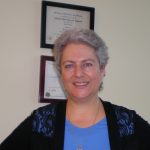Janette Sperber (photo by Olga Livshin)
Three decades ago, Janette Sperber experienced the benefits of biofeedback personally. “At the time, I lived in San Francisco and worked in social services with abused children,” she recalled in an interview with the Independent. “I had severe asthma, went to the emergency in a hospital at least twice a year with my asthma attacks. In 1987, I became a research subject. One of the pioneers in biofeedback in America conducted a study in the new protocols for treating asthma, and I jumped at the opportunity. The program lasted for 13 weeks and it revolutionized my life.”
Since then, Sperber has never gone to emergency again. Although her asthma didn’t disappear, the program helped her manage her condition. It taught her the right breathing regimen, stress management and relaxation techniques. “Even my personality improved,” she said with a smile, “at least according to my friends. Maybe because the fear of asthma, of struggling for breath, was gone. My general way of relating to life changed. I felt more secure, more confident. Biofeedback led me from being a victim of asthma to being in control of my life. It empowered me.”
She became a huge proponent of biofeedback techniques. Whenever her coworkers complained of headaches or chronic pains, she taught them what she had learned in the program, and it helped them, too. After awhile, she started thinking of doing it professionally.
“I went for special training, took some additional classes and passed the licence exam in 1989,” she said. After a few years of working in physiotherapy clinics, she started her own biofeedback practice in San Francisco. Four years ago, she moved to Vancouver.
According to Sperber, biofeedback is a learning process, not a treatment. She teaches her clients how to manage certain physical and psychological conditions, including panic and anxiety disorders, recurring headaches, asthma, muscle-based dysfunctions and many others.
“It’s very gratifying to a counselor,” she said, “because biofeedback is a short-term process. People come to me with a complaint. I identify the problem and teach them how to deal with it, how they could help themselves. If they do their homework and practise, we both see positive results in a short time.”
One of the common problems with which she has helped her patients is chronic pain, including headaches and even cancer-related pains. “I don’t treat cancer,” she stressed, “but I can help people with the pain. When something hurts, we always want the pain to go away. We tighten our muscles to fight the pain, to resist it, but the tension often leads to the opposite results: the pain worsens. It triggers the alarm bells in our brains, and the stress level goes up, exacerbating the pain further. We need to relax instead.”
In addition to relaxation techniques, Sperber teaches her clients the right approach to breathing, which could also reduce anxiety and even prevent panic attacks. “With the optimal respiration patterns, my clients can catch a panic attack before it is fully developed, ‘nip it in the bud,’” she said.
The first stage of any treatment is to identify the source. For that, Sperber uses special sensors similar to the ones used in electrocardiogram testing. The test is painless. She applies electrodes to different parts of a client’s body to find the problem area and then teaches the client how to reduce the tension in that group of muscles. She also tests breathing and heartbeats before recommending certain techniques.
“Not everything works for everyone,” she warned, “but I try different techniques with each client to find what works best for them. The more open-minded my clients are, the better I can help them. They need to practise what I teach to get the best outcome. Those who don’t want to practise are unwilling to help themselves.”
Some of her more difficult patients include a perhaps unexpected group. “Women who are too nice are sometimes the hardest to help,” she said. “They go to their doctors with pain complaints, and the doctors recommend medications and suggest restrictions of what they should and shouldn’t do. Some doctors also recommend them to me or other biofeedback specialists. But, because these women – and it is usually women, not men – are too nice, they can’t say no. Someone asks them to do something extra at work or at home and they do it, even though it aggravates their conditions. They should learn to say no, to take better care of themselves.”
Another problem Sperber encountered recently is the gradual proliferation of fake biofeedback providers. “Biofeedback is growing in popularity,” she said. “More and more doctors recommend their patients to find a biofeedback specialist, but I’m only aware of a few other licensed biofeedback professionals besides myself in Vancouver. Lots of scams though. If you want to consult a biofeedback counselor, check the website of Biofeedback Certification International Alliance – bcia.org – for the certified practitioners in your area.”
Sperber loves what she does. “It’s wonderful to be able to help people improve the quality of their lives,” she said.
Sperber’s website is theempoweredlife.ca.
Olga Livshin is a Vancouver freelance writer. She can be reached at [email protected].

